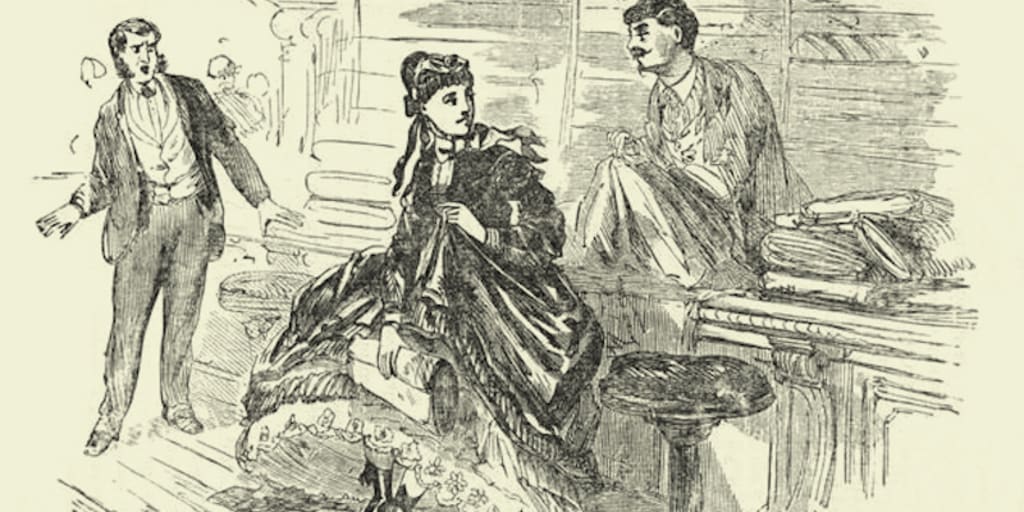MOST GLAMOROUS GANG IN LONDON HISTORY
Regarding "Alice Diamond, Queen of Thieves, and her 'girls' from The Forty Thieves, who stole their way to notoriety in the first half of the twentieth century."

"On Alice Diamond, Queen of Thieves, and her "girls" from The Forty Thieves, who stole their way to notoriety in the first half of the twentieth century," according to the citation. The tall, fashionable woman lingered next to a rack of fur coats in an upscale department store in London, her diamond rings glistening as her fingers caressed the most opulent sable.
Even though World War Two was over, rationing persisted, so purchasing such a lovely garment would have required more than six months' pay. The shopkeeper had no qualms about turning her back to assist another woman in trying on a silk nightgown because this lady was obviously wealthy. The fur was quickly snatched from its hanger, tightly rolled into a bundle, and shovingly stuffed into a special pair of shoplifter bloomers that the elegant thief was wearing beneath her skirt. As she walked out of the building and onto Oxford Street, where her sparkling Chrysler was waiting with the engine running, the sable coat sat there.
Five minutes later, she was joined by the woman who had been trying on a silk nightgown, and the two of them burst out laughing. For Alice Diamond, Queen of Thieves, and her "girls" from The Forty Thieves, who stole their way to fame in the first half of the twentieth century, it was yet another successful shopping trip. However, these women were not content with simply stealing expensive items like furs, jewellery, and silk stockings.
They used a scheme they called "hoisting." They were known for using hatpins or carrying razors in their handbags to slash or maim anyone who crossed them. Their antics made the Peaky Blinders look like a bunch of choirboys, according to official police and newspaper records, demonstrating that London's gangland during the turbulent first half of the 20th century was not just a man's world.
But a hoisters' code of secrecy that wouldn't be out of place in a Mafia film protected their criminal enterprise. It was difficult to locate individuals who had close ties to the gang and were willing to discuss them. My grandmother, who helped raise me in the 1970s, worked as a barmaid in the seedy pubs of Soho and Theatreland in the 1930s, when the Forty Thieves were at the height of their popularity. My family has been in London for generations, dating back to the 1800s.
She entertained me by singing old musical hall tunes from that era and telling amazing tales of a daring group of women who ran wild in West End shops, stuffing fur coats down their knickers and stealing jewellery. She would respond, "Don't care; don't care was made to care; don't care was hung; don't care was put in a pot and boiled 'til he was done," usually in response to me having a temper tantrum of some kind.
She would then explain to me that anyone who disobeyed the rules would eventually be caught, just like the nefarious women who ran through stores stuffing silks down long, red "drawers" that were elasticized at the knee to hold their loot. They were brutal and fearless, led by a "Queen" who was as tall as any man and had a knuckleduster made of a row of sparkling diamond rings, but even she was imprisoned.
When she said that, she always had a glint in her eye that made me smile and made me forget why I had been grumpy in the first place. I initially dismissed it as a make-believe tale, but many years later, when I started writing, I discovered that my grandmother had actually been telling the truth while researching a notorious London gangster. At his funeral, I had my first encounter with the forty thieves' descendants.
Many "faces" from London's underworld drank together and chatted about their previous criminal exploits at the wake, which was held in a South London pub. But the group of extremely beautiful women who had taken up residence in the pub's back room, away from the guys, caught my attention more. When I sauntered up to the bar and introduced myself, they were all dressed to the nines, including fur coats, and at first they were a little wary of me.
They started to open up to me about their private lives in the months that followed as we became close friends. They were the direct offspring of the Forty Thieves, whose mothers, grandmothers, and aunts had acquired their expertise from Alice Diamond, the most well-known of all the queens. Generations of families saw stealing as a way of life as the gang's secrets were passed down the female line.
Their only regret for engaging in criminal behaviour was getting caught, because doing so typically resulted in a stay in the dreary surroundings of Holloway Prison.
The Seven Dials neighbourhood in Covent Garden, which was notorious during the time of Charles Dickens, is where the gang is thought to have its origins. By the 1920s, the drab South London terraces and tenements served as the army's recruitment grounds. Their specialty was "hoisting," which involved stealing items from West End shops, and "clouting," which involved stuffing the stolen items down their bulky underwear, which had elastic at the knee to hold the items. From the 1920s on, Alice Diamond served as the leader of the all-girl gang.
Despite being a product of the workhouse, she lived a life of great wealth thanks to her skill as a thief and gang leader. She had a cool demeanour, was nearly six feet tall, and could punch as hard as any man. Her assailants appeared to be movie stars, with perfectly styled hair and fashionable attire. They had razors in their possession that were wrapped in lace handkerchiefs, and they had no qualms about using their hatpins to blind anyone who crossed them, be it the police or gangsters trying to take over their lucrative business.
The most shocking part was that some of the women I got to know, whose female relatives had received instruction from Alice Diamond, were still using their criminal skills to steal expensive clothing, sometimes donning hoisters' drawers as they fled with their booty. "The only thing straight about me, love, is my underwear; the rest is stolen," one immaculately dressed lady admitted. She informed me that she would be working in the shops later that afternoon when I took another person to lunch.
I assumed she had a job, but I suddenly regretted being so naive after seeing her whip out some scissors and a tool to remove security tags from her handbag. I naturally gave my justifications and left. I combed through secret police files on the group in the National Archives, finding pictures of the "Forty Thieves," who made a splash with their crimes.
Queen of Thieves' plot and characters are made up, but the records clearly show that some of their exploits were unbelievable. It's time to tell their story because their chapter of criminal history demonstrates that gangland was not just a world for men. (“The Most Glamorous Gang in London History”)
About the Creator
Elle
I love to write and share my stories with others! Writing is what gives me peace.
Enjoyed the story? Support the Creator.
Subscribe for free to receive all their stories in your feed. You could also pledge your support or give them a one-off tip, letting them know you appreciate their work.






Comments
There are no comments for this story
Be the first to respond and start the conversation.